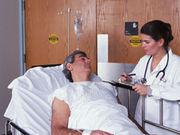Most common causes of readmission were procedural complications, sepsis, diabetes complications
TUESDAY, Dec. 5, 2017 (HealthDay News) — For patients with peripheral arterial disease who are discharged following peripheral arterial revascularization, 17.6 percent have 30-day nonelective readmission, according to a study published online Dec. 5 in the Annals of Internal Medicine.
Eric A. Secemsky, M.D., from the Beth Israel Deaconess Medical Center in Boston, and colleagues examined readmissions after peripheral arterial revascularization for peripheral arterial disease in a retrospective cohort study. Data were included for 61,969 unweighted hospitalizations of patients with peripheral arterial disease who were discharged from 1,085 U.S. acute care hospitals.
The researchers found that the 30-day elective readmission rate was 17.6 percent among patients discharged alive after peripheral arterial revascularization. The most common causes of readmission were procedural complications, sepsis, and complications due to diabetes mellitus (28.0, 8.3, and 7.5 percent). Twenty-one percent of rehospitalized patients underwent a subsequent peripheral arterial revascularization or lower extremity amputation and 4.6 percent died. Readmission had a median cost of $11,013. There was variation in the 30-day risk-standardized readmission rates between hospitals, from 10.0 to 27.3 percent.
“More than one in six patients with peripheral arterial disease who undergo peripheral arterial revascularization have unplanned readmission within 30 days, with high associated mortality risks and costs,” the authors write.
Several authors disclosed financial ties to the pharmaceutical and health care industries.
Copyright © 2017 HealthDay. All rights reserved.








